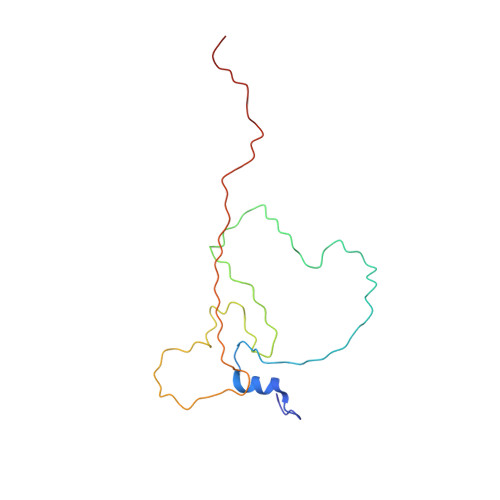Intrinsically Disordered Bacterial Polar Organizing Protein Z, PopZ, Interacts with Protein Binding Partners Through an N-terminal Molecular Recognition Feature.
Nordyke, C.T., Ahmed, Y.M., Puterbaugh, R.Z., Bowman, G.R., Varga, K.(2020) J Mol Biol 432: 6092-6107
- PubMed: 33058876
- DOI: https://doi.org/10.1016/j.jmb.2020.09.020
- Primary Citation of Related Structures:
6XRY - PubMed Abstract:
The polar organizing protein Z (PopZ) is necessary for the formation of three-dimensional microdomains at the cell poles in Caulobacter crescentus, where it functions as a hub protein that recruits multiple regulatory proteins from the cytoplasm. Although a large portion of the protein is predicted to be natively unstructured, in reconstituted systems PopZ can self-assemble into a macromolecular scaffold that directly binds to at least ten different proteins. Here we report the solution NMR structure of PopZ Δ134-177 , a truncated form of PopZ that does not self-assemble but retains the ability to interact with heterologous proteins. We show that the unbound form of PopZ Δ134-177 is unstructured in solution, with the exception of a small amphipathic α-helix in residues M10-I17, which is included within a highly conserved region near the N-terminal. In applying NMR techniques to map the interactions between PopZ Δ134-177 and one of its binding partners, RcdA, we find evidence that the α-helix and adjoining amino acids extending to position E23 serve as the core of the binding motif. Consistent with this, a point mutation at position I17 severely compromises binding. Our results show that a partially structured Molecular Recognition Feature (MoRF) within an intrinsically disordered domain of PopZ contributes to the assembly of polar microdomains, revealing a structural basis for complex network assembly in Alphaproteobacteria that is analogous to those formed by intrinsically disordered hub proteins in other kingdoms.
Organizational Affiliation:
Department of Molecular, Cellular and Biomedical Sciences, University of New Hampshire, Durham, NH 03824, United States.














